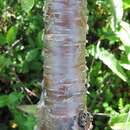en
names in breadcrumbs


Betula fruticosa, commonly known as dwarf bog birch,[1] (traditional Chinese: 柴樺; simplified Chinese: 柴桦; pinyin: chái huà) is a species of dwarf birch that grows in central and eastern Europe (except for Finland where it grows rare) and Siberia and Mongolia[2] on elevation of 600–1,100 metres (2,000–3,600 ft) in forests, streambanks, and swamps.[3]
The species is 3 metres (9.8 ft) tall and have glabrous branches that are either purplish-brown or grayish-black in colour. Petiole is 2–10 millimetres (0.079–0.394 in) long and is a hairless as the branches. The peduncle is 2–5 millimetres (0.079–0.197 in) long but can sometimes be even 10 millimetres (0.39 in). Female species have an oblong inflorescence which is erect as well. The bracts are ciliate, 4–7 millimetres (0.16–0.28 in) long, and have elliptic nutlets. The flowers bloom from June to July and the fruits ripe from July to August.[3]
{{cite journal}}: Cite journal requires |journal= (help) Betula fruticosa, commonly known as dwarf bog birch, (traditional Chinese: 柴樺; simplified Chinese: 柴桦; pinyin: chái huà) is a species of dwarf birch that grows in central and eastern Europe (except for Finland where it grows rare) and Siberia and Mongolia on elevation of 600–1,100 metres (2,000–3,600 ft) in forests, streambanks, and swamps.